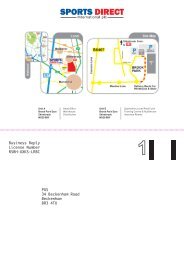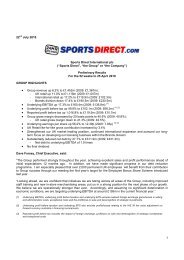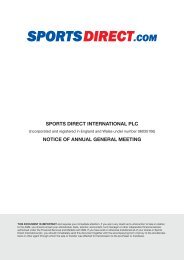Dave Forsey Chief Executive 19 July 2012 - Sports Direct International
Dave Forsey Chief Executive 19 July 2012 - Sports Direct International
Dave Forsey Chief Executive 19 July 2012 - Sports Direct International
Create successful ePaper yourself
Turn your PDF publications into a flip-book with our unique Google optimized e-Paper software.
notes to the Financial Statements<br />
For the 53 weeks ended 29 April <strong>2012</strong><br />
1. Accounting policies<br />
The consolidated financial statements of <strong>Sports</strong> <strong>Direct</strong> <strong>International</strong><br />
plc (the “Company”) and its subsidiaries (together the “Group”) have<br />
been prepared in accordance with <strong>International</strong> Financial Reporting<br />
Standards as adopted by the European Union (“IFRS”).<br />
Basis of preparation<br />
The consolidated financial statements have been prepared<br />
in accordance with IFRS as adopted for use in the European<br />
Union (including <strong>International</strong> Accounting Standards (“IAS”) and<br />
<strong>International</strong> Financial Reporting Standards Committee (“IFRSC”)<br />
interpretations) and with those parts of the Companies Act 2006<br />
applicable to companies reporting under IFRS as adopted for use<br />
in the European Union. The consolidated financial statements have<br />
been prepared under the historical cost convention, as modified<br />
to include fair valuation of certain financial assets and derivative<br />
financial instruments.<br />
Consolidation<br />
The consolidated financial statements consolidate the revenues,<br />
costs, assets, liabilities and cash flows of the Company and its<br />
subsidiaries, being those entities in relation to which the Company<br />
has the power to govern the financial and operating policies,<br />
generally achieved by a share of more than 50% of the voting rights.<br />
On acquisition, the assets and liabilities and contingent liabilities<br />
of a subsidiary are measured at their fair values at the date of<br />
acquisition. Any excess of fair value of the consideration transferred<br />
over the fair values of the identifiable net assets acquired is<br />
recognised as goodwill. Any deficiency of fair value of consideration<br />
transferred below the fair values of the identifiable net assets<br />
acquired is credited to the consolidated income statement in the<br />
period of acquisition. The non-controlling interest is stated at the<br />
non-controlling interest’s proportion of the fair values of the assets,<br />
liabilities and contingent liabilities recognised.<br />
The results of subsidiaries acquired or disposed of during the<br />
year are included in the consolidated income statement from the<br />
effective date of acquisition or up to the effective date of disposal,<br />
as appropriate.<br />
Inter-company transactions, balances and unrealised gains and<br />
losses on transactions between Group companies are eliminated.<br />
Associates and joint ventures<br />
Associates are entities over which the Group has significant<br />
influence but not control, generally accompanied by a share of<br />
between 20% and 50% of the voting rights.<br />
A joint venture is an entity in which the Group holds an interest on<br />
a long-term basis and which is jointly controlled by the Group and<br />
one or more other venturers under a contractual agreement.<br />
The Group’s share of the results of associates and joint ventures is<br />
included in the Group’s consolidated income statement using the<br />
equity method of accounting. Investments in associates and joint<br />
ventures are carried in the Group’s consolidated balance sheet at<br />
cost plus post acquisition changes in the Group’s share of the net<br />
assets of the associates and joint ventures, less any impairment in<br />
value. The carrying values of investments in associates and joint<br />
ventures include acquired goodwill.<br />
If the Group’s share of losses in an associate or joint venture equals<br />
or exceeds its investment in the associate or joint venture, the<br />
Group does not recognise further losses, unless it has incurred<br />
obligations to do so or made payments on behalf of the associate<br />
or joint venture.<br />
Unrealised gains arising from transactions with associates and<br />
joint ventures are eliminated to the extent of the Group’s interest<br />
in the entity.<br />
Investments<br />
Available-for-sale investments are initially recognised at fair value.<br />
Where fair value is different to cost, this is recognised in the<br />
income statement on initial recognition. Subsequent gains and<br />
losses arising from changes in fair value are recognised in other<br />
comprehensive income through the statement of comprehensive<br />
income, until the security is disposed or de-recognised at which<br />
time the cumulative gain or loss previously recognised in other<br />
comprehensive income is reclassified from equity to the income<br />
statement as a reclassification adjustment in the consolidated<br />
income statement for the period. If an available-for-sale investment<br />
is determined to be impaired, the cumulative loss that had been<br />
recognised in other comprehensive income is reclassified from<br />
equity to profit or loss.<br />
Acquisitions<br />
For business combinations achieved in stages, the Group<br />
remeasures its previously held equity interest in the acquiree at<br />
its acquisition date fair value and recognises the resulting gain<br />
or loss, if any, in profit or loss or other comprehensive income,<br />
as appropriate.<br />
Goodwill<br />
Goodwill arising on consolidation is recognised as an asset and<br />
reviewed for impairment at least annually or when a change in<br />
circumstances or situation indicates that the goodwill has suffered<br />
an impairment loss. Any impairment is recognised immediately<br />
in the income statement. Gains and losses on the disposal of a<br />
business include the amount of goodwill relating to that business.<br />
When the non-controlling interest of an existing subsidiary is<br />
acquired the carrying value of the non-controlling interests in the<br />
balance sheet is eliminated. Any difference between the amount by<br />
which the non-controlling interest is adjusted and the fair value of<br />
the consideration paid is recognised directly in equity.<br />
Other intangible assets<br />
Brands, trade marks and licences that are internally generated are<br />
not recorded on the balance sheet. Acquired brands, trade marks<br />
and licences are initially carried on the balance sheet at cost. The<br />
fair value of brands, trade marks and licences that are acquired<br />
by virtue of a business combination is determined at the date of<br />
acquisition and is subsequently assessed as being the deemed<br />
cost to the Group.<br />
73<br />
No amortisation is charged on brands, trade marks or perpetual /<br />
renewable licences with an indefinite life as the Group believes<br />
that the value of these brands and trade marks can be maintained<br />
indefinitely. The Group carries out an impairment review of indefinite<br />
life intangibles, at least annually, or when a change in circumstances<br />
or situation indicates that those intangibles have suffered an<br />
impairment loss.



![Our ref: [ ] - Sports Direct International](https://img.yumpu.com/19248141/1/184x260/our-ref-sports-direct-international.jpg?quality=85)





![Our ref: [ ] - Sports Direct International](https://img.yumpu.com/18440214/1/184x260/our-ref-sports-direct-international.jpg?quality=85)

